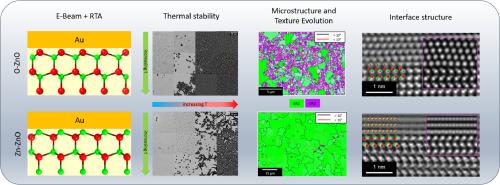当前位置:
X-MOL 学术
›
Acta Mater.
›
论文详情
Our official English website, www.x-mol.net, welcomes your
feedback! (Note: you will need to create a separate account there.)
Influence of substrate polarity on thermal stability, grain growth and atomic interface structure of Au thin films on ZnO surfaces
Acta Materialia ( IF 8.3 ) Pub Date : 2024-11-03 , DOI: 10.1016/j.actamat.2024.120531 Martin Dierner, Michael Landes, Johannes Will, Andreas Ziegler, Sabine Hübner, Thomas Przybilla, Tobias Zech, Tobias Unruh, Bernd Meyer, Erdmann Spiecker
Acta Materialia ( IF 8.3 ) Pub Date : 2024-11-03 , DOI: 10.1016/j.actamat.2024.120531 Martin Dierner, Michael Landes, Johannes Will, Andreas Ziegler, Sabine Hübner, Thomas Przybilla, Tobias Zech, Tobias Unruh, Bernd Meyer, Erdmann Spiecker

|
The influence of the polarity of ceramic substrates on the structural evolution of thin metal films during annealing at elevated temperatures is investigated, including the competing processes of solid state dewetting (SSD) and grain growth, as well as the atomic structure of the epitaxial interface. For this purpose, Au thin films on polar O-ZnO( 000 1 ‾ ) ( 0001 ) 11 2 ¯ 0 10 1 ¯ 0
中文翻译:

衬底极性对 ZnO 表面 Au 薄膜的热稳定性、晶粒生长和原子界面结构的影响
研究了陶瓷衬底极性对高温退火过程中金属薄膜结构演变的影响,包括固态去湿 (SSD) 和晶粒生长的竞争过程,以及外延界面的原子结构。为此,极性 O-ZnO(0001 ̅) 和 Zn-ZnO(0001) 表面上的 Au 薄膜在高温和时间下退火。SSD 在 O 封端表面上占主导地位,而在 Zn 封端表面上观察到明显的晶粒生长。质构分析表明,在 600 °C 的温度下,两个样品都表现出纤维质构,其中 Au(111) 略占主导地位[110] ||ZnO(0001)[112 ̄0] 取向关系 (OR 2)。在 800 °C 时,Zn-ZnO 上的 Au 与 Au(111) [110] ||ZnO(0001)[101 ̄0] 取向关系 (OR 1)。密度泛函理论 (DFT) 中各种界面结构的比较表明,Au(111) 薄膜和理想的体截短极性 ZnO 表面之间的原子尖锐界面在能量上有利于两种衬底极性,与原子分辨电子显微镜非常一致。由于 OR 2 中重合位点晶格的周期较大,相应的界面可以描述为半相干的,具有明显分离的错拟合位错。相比之下,OR 1 中(近似)重合位点晶格的较小周期导致与局部重建的界面在很大程度上不连贯。然而,在实验情况下,即使与完美 OR 1 的旋转偏差很小,也会在不相干的界面结构上引入一个界面螺旋位错网络,有效地使界面半相干。
更新日期:2024-11-03
中文翻译:

衬底极性对 ZnO 表面 Au 薄膜的热稳定性、晶粒生长和原子界面结构的影响
研究了陶瓷衬底极性对高温退火过程中金属薄膜结构演变的影响,包括固态去湿 (SSD) 和晶粒生长的竞争过程,以及外延界面的原子结构。为此,极性 O-ZnO(0001 ̅) 和 Zn-ZnO(0001) 表面上的 Au 薄膜在高温和时间下退火。SSD 在 O 封端表面上占主导地位,而在 Zn 封端表面上观察到明显的晶粒生长。质构分析表明,在 600 °C 的温度下,两个样品都表现出纤维质构,其中 Au(111) 略占主导地位[110] ||ZnO(0001)[112 ̄0] 取向关系 (OR 2)。在 800 °C 时,Zn-ZnO 上的 Au 与 Au(111) [110] ||ZnO(0001)[101 ̄0] 取向关系 (OR 1)。密度泛函理论 (DFT) 中各种界面结构的比较表明,Au(111) 薄膜和理想的体截短极性 ZnO 表面之间的原子尖锐界面在能量上有利于两种衬底极性,与原子分辨电子显微镜非常一致。由于 OR 2 中重合位点晶格的周期较大,相应的界面可以描述为半相干的,具有明显分离的错拟合位错。相比之下,OR 1 中(近似)重合位点晶格的较小周期导致与局部重建的界面在很大程度上不连贯。然而,在实验情况下,即使与完美 OR 1 的旋转偏差很小,也会在不相干的界面结构上引入一个界面螺旋位错网络,有效地使界面半相干。

































 京公网安备 11010802027423号
京公网安备 11010802027423号